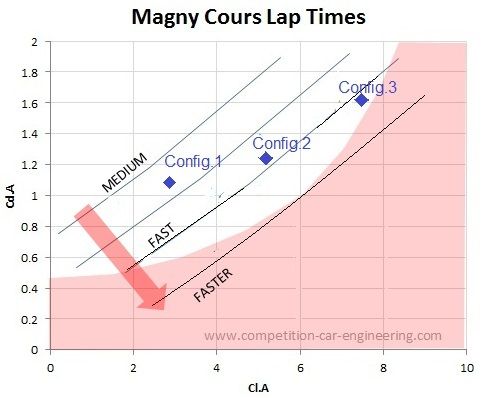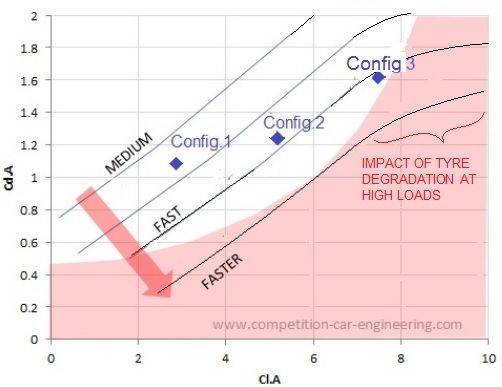- Login or Register
No account yet? Sign up
That is actually very true. I did not think about it that way. I thought adding some more complexity and realism would make the whole thing even more interesting. But in the end you are just changing the gradient of the optimal design (I guess, utility function to be more accurate) we are trying to reach. So nothing would really change.machin wrote: The impact on you guys is simply that the "lines of equal laptime" on the chart I posted in the 2015 thread will be slightly lower gradient
I dont' think it would be the best choice: the greater the engine power, the smaller the relevance of aerodynamic efficiency. Basically, the differences between a good, refined design and a generic design would be eclipsed by the engine: this is not going to promote interesting and smart aero solutions...UlleGulle wrote:The first thing I would change is the engine. This is a fantasy race-car design championship. Let's put a tuned up bugatti Veyron engine in there. A huge engine with huge cooling needs, and a shitload of power. Let's have 430km/h race-duels.
Yes, but if we further increase variety, the newcomers and inexperienced ones may be totally disoriented... We have yet to understand which is this season's best design layout!UlleGulle wrote:Go for more aero opting.
This is a delicate aspect as well:UlleGulle wrote:One thing I'd like is to partition three different parts of three tracks each.
Tyre management is a delicate topic... More downforce doesn't necessarily translates into more wear. Tyres work better (=more grip, less wear) at a given temperature, often studied to suit car's performance: it would be illogical to assume that the compound hypothetically chosen for this championship suits best the less performing cars...machin wrote:I could introduce a wear rate such that as the tyres get used the coefficient of friction reduces; more load on the tyres means higher wear rate, so by the end of the lap the higher downforce cars see a bigger reduction in tyre coefficient...?
Let's bring the problem to the extremes: an engine with infinite power would allow us to design cars without taking care of drag at all; we would run maximum downforce setup even at Monza. Instead, an engine with ridicolously low power would impose us to look for the most efficient solution and study for smarter ideas.UlleGulle wrote:I don't really understand your reasoning about the engine. With all cars having the same engine, and therefore power, wouldn't the difference between a good design and a bad one be the same? The only changes I could think of is a bigger challenge in terms of packaging, more bias towards streamlining and rear downforce. However, I can be totally wrong.
Hi!qwerty2459 wrote:hey guys, ive been following this years competition and its very nice to read and follow and i can really see myself as being part of it. i registered on the site today just so that i can talk to you guys about it and im very tempted to join next years as a beginner but im not sure how to start, my problem right now is what CAD software you guys use to create, once ill know which one it is ill try to learn it so that i can have enough time to join in the competition.
Damn it. Through simple logic you proved me wrong. By internet forum rules I must now resort to name calling. You... you ... Honda Power Unit!variante wrote: Let's bring the problem to the extremes: an engine with infinite power would allow us to design cars without taking care of drag at all; we would run maximum downforce setup even at Monza. Instead, an engine with ridicolously low power would impose us to look for the most efficient solution and study for smarter ideas.
In the first scenario a car with huge amount of downforce produced in an extremely inefficient way would win over another car which lacks just a bit of downforce but is remarkably efficient...not very fair! All the season would be similar to Monaco!
(BTW i don't want the ridicolously low powered engine either...let's look for something in the middle)
This is incorrect. If you have more downforce you are just pushing further the limit but when you drive, you drive at the limit.variante wrote:Tyre management is a delicate topic... More downforce doesn't necessarily translates into more wear. Tyres work better (=more grip, less wear) at a given temperature, often studied to suit car's performance: it would be illogical to assume that the compound hypothetically chosen for this championship suits best the less performing cars...machin wrote:I could introduce a wear rate such that as the tyres get used the coefficient of friction reduces; more load on the tyres means higher wear rate, so by the end of the lap the higher downforce cars see a bigger reduction in tyre coefficient...?
Also, more downforce means less oversteering/drifting, less wheel locking, which translates into LESS tyre wear.
Finally, i've always got the impression that our races are more similar to qualifying session rather that proper races: would tire wear be a discriminating factor over just one lap?
Yes, i'm against the introduction of this change: too many variables we can't manage properly, as well as unnecessary added complexity.
Yes, good consideration!MadMatt wrote:If you have more downforce you are just pushing further the limit but when you drive, you drive at the limit.We were at Monza last week (I say we, but I mean F1), even at 350km/h you can lock wheels and yet at 350km/h they generate huge amount of downforce. Its just a matter of moving the limit further or earlier.
Exactly, and I quote myself from the previous page: "Plus having more downforce makes things easier for the driver (your car is not sliding all the time)."variante wrote:Yes, good consideration!MadMatt wrote:If you have more downforce you are just pushing further the limit but when you drive, you drive at the limit.We were at Monza last week (I say we, but I mean F1), even at 350km/h you can lock wheels and yet at 350km/h they generate huge amount of downforce. Its just a matter of moving the limit further or earlier.
I was thinking about real life conditions, where a pilot with less downforce will always make more mistakes (i.e. more oversteering, locking,...) trying to catch up with the more performing cars (whose pilots, in turn, will be more confident of their position and less prone to mistakes).
But, since our cars are driven by computers, you're right!
In reality Virtual Stopwatch is "supplying" the tyre, so there is no "assumption"; currently we're running a tyre model that was decided (Or "designed") by me without any input... but I could "design" any tyre characteristics we want... drop off at high loads due to overuse, drop off at low loads due to low temperature, etc. etc.....variante wrote: it would be illogical to assume that the compound hypothetically chosen for this championship suits best the less performing cars...
At the moment the tyre model I'm using is one I developed for predicting the performance of cars competing in the UK sprint championship; which is for short distance events and shows no drop off; I think its OK for our purposes. However, I remember times not so long ago when drivers in F1 would report that the tyres were "going-off" at the end of one qualifying lap. For me adding this characteristic is just a few taps of the keyboard away (Ok, a little more than that, but not too bad...) if we want to go that way....Finally, i've always got the impression that our races are more similar to qualifying session rather that proper races: would tire wear be a discriminating factor over just one lap?
As with all of these things being suggested (e.g. the ability of more efficient cars to run with less fuel, or to have a slightly increased power output to use up any remaining fuel), the only outcome for you guys as competitors is that it changes the shape/gradient of the lines of equal lap time (that I've labelled "Medium" "Fast" and "Faster" in the diagram below): you'll still put your aero coefficients into Virtual Stopwatch and get a lap time out: all these tyre degradation formulas/fuel saving formulas will be automatically considered... So the additional work is only for me on the programming side really....Yes, i'm against the introduction of this change: too many variables we can't manage properly, as well as unnecessary added complexity.


I thought adding some more complexity and realism would make the whole thing even more interesting. But in the end you are just changing the gradient of the optimal design (I guess, utility function to be more accurate) we are trying to reach. So nothing would really change.
That is exactly how Virtual Stopwatch works: it drives at the limit of the tyre with the least amount of relative grip at all times unless some other variable is the limiting factor (e.g. during acceleration engine power, drag, gearing etc. are the limiting factors most of the time, with tyres, the forces on them and the transmission configuration (FWD, RWD or 4WD) only the limiting factor to acceleration at low speeds), so in essence there is no extra "margin" or "less sliding" with more downforce in the Virtual Stopwatch simulation, only more speed due to the higher limit.If you have more downforce you are just pushing further the limit but when you drive, you drive at the limit
Ok, then: it would be illogical to "decide" that the compound hypothetically chosen for this championship suits best the less performing cars...machin wrote:In reality Virtual Stopwatch is "supplying" the tyre, so there is no "assumption"; currently we're running a tyre model that was decided (Or "designed") by me without any input... but I could "design" any tyre characteristics we want...
Indeed. BTW i could even say that tyre degradation could be an enjoyable challenge for us, but not a realistic one (unless we want to simulate a full GP).machin wrote:On the flip side you could argue that the fact that since the tyre degradation has no real impact on the method competitors should use to design their cars (and therefore no increase in the "enjoyment" a competitor gets from adding this feature), there is also no real advantage in adding this tyre degradation feature either, since we can also change the shape/gradient of these lines of equal lap time by increasing/decreasing engine power, changing gearing ratios, changing engine inertia, or simply choosing other tracks to visit....
No, it's not in contrast. Competitors dealing with engine/cooling inlet to get extract more performance from the engine is totally normal in real world (while i've never seen a car decreasing downforce to preserve its tyres...maybe the opposite, especially during qualy laps), and that rule would elegantly get rid of other restrictive and artificially imposed rules governing inlets position.machin wrote:This contrasts quite a bit with the desire to introduce engine power output modifications based on airflow/pressure on the inlet and cooling intake surfaces: that request certainly adds complexity and more variables for both the competitor and the organisers to handle....